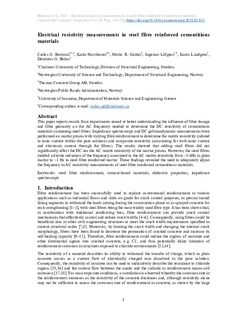| dc.contributor.author | Berrocal, Carlos G. | |
| dc.contributor.author | Hornbostel, Karla | |
| dc.contributor.author | Geiker, Mette Rica | |
| dc.contributor.author | Löfgren, Ingemar | |
| dc.contributor.author | Lundgren, Karin | |
| dc.contributor.author | Bekas, Dimitrios G. | |
| dc.date.accessioned | 2018-12-11T11:26:55Z | |
| dc.date.available | 2018-12-11T11:26:55Z | |
| dc.date.created | 2018-03-22T10:40:13Z | |
| dc.date.issued | 2018 | |
| dc.identifier.citation | Cement & Concrete Composites. 2018, 89 216-229. | nb_NO |
| dc.identifier.issn | 0958-9465 | |
| dc.identifier.uri | http://hdl.handle.net/11250/2577100 | |
| dc.description.abstract | This paper reports results from experiments aimed at better understanding the influence of fibre dosage and fibre geometry on the AC frequency needed to determine the DC resistivity of cementitious materials containing steel fibres. Impedance spectroscopy and DC galvanodynamic measurements were performed on mortar prisms with varying fibre reinforcement to determine the matrix resistivity (related to ionic current within the pore solution) and composite resistivity (accounting for both ionic current and electronic current through the fibres). The results showed that adding steel fibres did not significantly affect the DC nor the AC matrix resistivity of the mortar prisms. However, the steel fibres yielded a drastic reduction of the frequency associated to the AC matrix resistivity from ∼1 kHz in plain mortar to ∼1 Hz in steel fibre reinforced mortar. These findings revealed the need to adequately adjust the frequency in AC resistivity measurements of steel fibre reinforced cementitious materials. | nb_NO |
| dc.language.iso | eng | nb_NO |
| dc.publisher | Elsevier | nb_NO |
| dc.rights | Attribution-NonCommercial-NoDerivatives 4.0 Internasjonal | * |
| dc.rights.uri | http://creativecommons.org/licenses/by-nc-nd/4.0/deed.no | * |
| dc.title | Electrical resistivity measurements in steel fibre reinforced cementitious materials | nb_NO |
| dc.title.alternative | Electrical resistivity measurements in steel fibre reinforced cementitious materials | nb_NO |
| dc.type | Journal article | nb_NO |
| dc.type | Peer reviewed | nb_NO |
| dc.description.version | acceptedVersion | nb_NO |
| dc.source.pagenumber | 216-229 | nb_NO |
| dc.source.volume | 89 | nb_NO |
| dc.source.journal | Cement & Concrete Composites | nb_NO |
| dc.identifier.doi | 10.1016/j.cemconcomp.2018.03.015 | |
| dc.identifier.cristin | 1574906 | |
| dc.description.localcode | © 2018. This is the authors’ accepted and refereed manuscript to the article. Locked until 19.3.2020 due to copyright restrictions. This manuscript version is made available under the CC-BY-NC-ND 4.0 license http://creativecommons.org/licenses/by-nc-nd/4.0/ | nb_NO |
| cristin.unitcode | 194,64,45,0 | |
| cristin.unitname | Institutt for konstruksjonsteknikk | |
| cristin.ispublished | true | |
| cristin.fulltext | postprint | |
| cristin.qualitycode | 1 | |

